
Little Girl Observing Lovers on a Train, also known as Travel Experience or Voyeur, is a painting by American illustrator Norman Rockwell. It was originally created for the cover of The Saturday Evening Post on 12 August 1944.

Little Girl Observing Lovers on a Train, also known as Travel Experience or Voyeur, is a painting by American illustrator Norman Rockwell. It was originally created for the cover of The Saturday Evening Post on 12 August 1944.
Rockwell came up with the idea for the painting when traveling by train with servicemen and their families. [1] The models posed for the reference photos in an unused rail car on a siding of the Rutland Railway. Rockwell was displeased with the area around the heads of the couple in his sketch that led to the final painting and covered the area with an additional sheet of paper to get the couple's pose right. [1]
Little Girl Observing Lovers on a Train depicts a crowded passenger train car. A young faceless couple can be seen cuddling in one of the seats; their heads are together and their legs are intertwined on top of some luggage in the seat facing directly in front of them. [2] The man's Army Air Force jacket hangs above the couple. The focus point of the painting is a six-year-old girl in the seat in front of the couple who is next to her mother. Unnoticed by the pair, she is kneeling on her seat and watching them. [3] She appears to be uninterested in the intimate moment. [4] The arm of the conductor, with a ticket in hand, can be seen in the background. The "Dixie Cup" hat of a United States Navy Sailor and the hair of his partner can be seen in the seat behind the couple.
Popular-art historian Christopher Finch found the painting to be a good example of Rockwell's matured style and compared the painting to a Henri Cartier-Bresson photo. [5]
The painting has been in the permanent collection of the Memorial Art Gallery in Rochester, New York since 1974. [6]
The pencil sketch for this painting is in the personal collection of George Lucas and was included in fellow filmmaker Steven Spielberg's and his 2010 show at the Smithsonian American Art Museum. [7] [1]

Norman Percevel Rockwell was an American painter and illustrator. His works have a broad popular appeal in the United States for their reflection of the country's culture. Rockwell is most famous for the cover illustrations of everyday life he created for The Saturday Evening Post magazine over nearly five decades. Among the best-known of Rockwell's works are the Willie Gillis series, Rosie the Riveter, The Problem We All Live With, Saying Grace, and the Four Freedoms series. He is also noted for his 64-year relationship with the Boy Scouts of America (BSA), during which he produced covers for their publication Boys' Life, calendars, and other illustrations. These works include popular images that reflect the Scout Oath and Scout Law such as The Scoutmaster, A Scout Is Reverent and A Guiding Hand, among many others.

Rockwell Kent was an American painter, printmaker, illustrator, writer, sailor, adventurer and voyager.

The Norman Rockwell Museum is an art museum in Stockbridge, Massachusetts, United States, dedicated to the art of Norman Rockwell. It is home to the world's largest collection of original Rockwell art. The museum also hosts traveling exhibitions pertaining to American illustration.
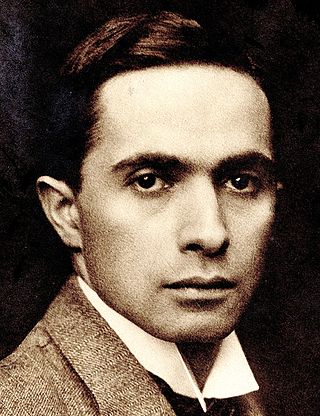
Joseph Christian Leyendecker was one of the most prominent and financially successful freelance commercial artists in the U.S. He was active between 1895 and 1951 producing drawings and paintings for hundreds of posters, books, advertisements, and magazine covers and stories. He is best known for his 80 covers for Collier's Weekly, 322 covers for The Saturday Evening Post, and advertising illustrations for B. Kuppenheimer men's clothing and Arrow brand shirts and detachable collars. He was one of the few known gay artists working in the early-twentieth century U.S.

Harvey Thomas Dunn NA, also known as J. Harvey Dunn, was an American painter and teacher. During World War I, Dunn was an artist-correspondent with the American Expeditionary Forces in Europe. Most of Dunn's war sketches are housed at the Smithsonian Institution in the National Museum of American History in Washington, D.C. He is best known for his prairie-intimate masterpiece, The Prairie is My Garden (1950). In this painting, a mother and her two children are out gathering flowers from the quintessential prairie of the Great Plains.
William J. Obanhein, also known as Officer Obie, was the chief of police for the town of Stockbridge, Massachusetts. He was a member of the police force there for 34 years, 1951 to 1985. He is fairly well known for his appearances in popular culture.

Breaking Home Ties is a painting by American illustrator Norman Rockwell, created for the September 25, 1954, cover of The Saturday Evening Post. The picture represents a father and son waiting for a train that will take the young man to the state university. The painting, considered by experts to be one of Rockwell's masterworks, is also one of the most widely reproduced, and was voted the second-most popular image in Post history.

John Philip Falter was an American artist best known for his many cover paintings for The Saturday Evening Post.

Russian Schoolroom (1967), also known as The Russian Classroom and Russian Schoolchildren, is an oil on canvas painting created by American illustrator Norman Rockwell (1894–1978) and commissioned by Look magazine. It depicts Soviet schoolchildren in a classroom with a bust of Soviet leader Vladimir Lenin.

Willie Gillis, Jr. is a fictional character created by Norman Rockwell for a series of World War II paintings that appeared on the covers of 11 issues of The Saturday Evening Post between 1941 and 1946. Gillis was an everyman with the rank of private whose career was tracked on the cover of the Post from induction through discharge without being depicted in battle. He and his girlfriend were modeled by two of Rockwell's acquaintances.
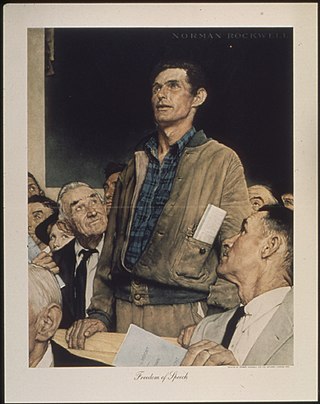
The Four Freedoms is a series of four oil paintings made in 1943 by the American artist Norman Rockwell. The paintings—Freedom of Speech, Freedom of Worship, Freedom from Want, and Freedom from Fear—are each approximately 45.75 by 35.5 inches, and are now in the Norman Rockwell Museum in Stockbridge, Massachusetts. The four freedoms refer to President Franklin D. Roosevelt's January 1941 Four Freedoms State of the Union address, in which he identified essential human rights that should be universally protected. The theme was incorporated into the Atlantic Charter, and became part of the Charter of the United Nations. The paintings were reproduced in The Saturday Evening Post over four consecutive weeks in 1943, alongside essays by prominent thinkers of the day. They became the highlight of a touring exhibition sponsored by The Post and the U.S. Department of the Treasury. The exhibition and accompanying sales drives of war bonds raised over $132 million.
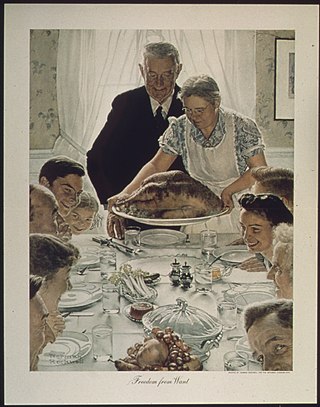
Freedom from Want, also known as The Thanksgiving Picture or I'll Be Home for Christmas, is the third of the Four Freedoms series of four oil paintings by American artist Norman Rockwell. The works were inspired by United States President Franklin D. Roosevelt's 1941 State of the Union Address, known as Four Freedoms.

The Love Song is an oil painting by American artist Norman Rockwell, located in the Indianapolis Museum of Art, which is in Indianapolis, Indiana, United States. It originally appeared in the Ladies Home Journal in December 1926. It depicts two elderly musicians, on flute and clarinet, playing a duet while a young girl takes a break from sweeping to listen. The painting's title appears on the sheet music from which the musicians play.

Children Dancing at a Party, produced by Norman Rockwell, was used as the cover for the January 26, 1918 issue of The Saturday Evening Post. This painting has also been called Boy Stepping on Girl's Toe and Pardon Me. The original painting, oil on canvas measuring 23x19 inches, is in the collection of the National Museum of American Illustration.

Saying Grace is a 1951 painting by American illustrator Norman Rockwell, painted for the cover of The Saturday Evening Post's November 24, 1951, Thanksgiving issue.

Drew Struzan is an American artist, illustrator and cover designer. He is known for his more than 150 movie posters, which include The Shawshank Redemption, Blade Runner, Mallrats, as well as films in the Indiana Jones, Back to the Future, and Star Wars film series. He has also painted album covers, collectibles, and book covers.

The Rookie or The Rookie is a 1957 painting by American artist Norman Rockwell, painted for the March 2, 1957, cover of The Saturday Evening Post magazine.
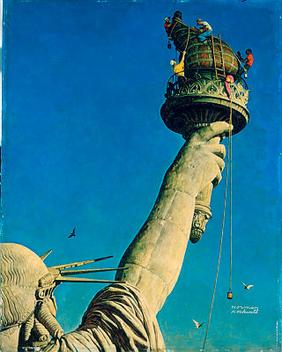
Working on the Statue of Liberty, also known as Statue of Liberty, is a 1946 oil painting by American illustrator Norman Rockwell, showing workmen cleaning the torch held aloft by the Statue of Liberty in New York Harbor.
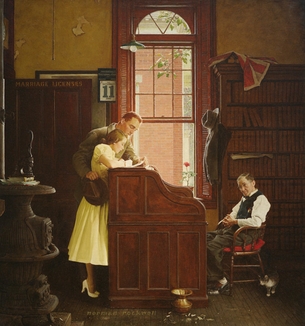
Marriage License is an oil painting by American illustrator Norman Rockwell created for the cover of the June 11, 1955, edition of The Saturday Evening Post. It depicts a young man and woman filling out a marriage license application at a government building in front of a bored-looking clerk. The man is dressed in a tan suit and has his arm around his partner, who is wearing a yellow dress and standing on tiptoe to sign her name. Although the room and its furnishings are dark, the couple are illuminated by the window beside them. The contrast between the couple and the clerk highlights two reoccurring themes in Rockwell's works: young love and ordinary life.